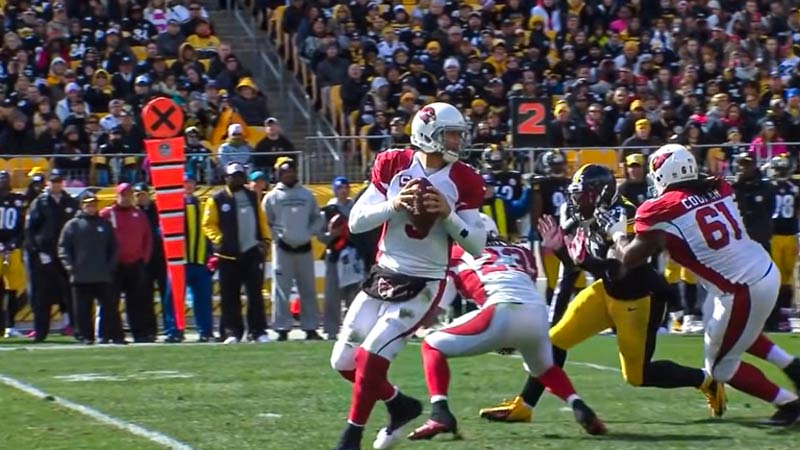In American football, the term “chop block” holds a distinctive place in the lexicon. It’s a technique that, while integral to offensive strategy, is also highly regulated and carries significant safety implications.
A chop block occurs when two offensive players work in tandem to block a single defensive player, one delivering a high block while the other strikes low.
This maneuver, aimed at immobilizing the defender, can be both strategic and dangerous. Football’s stringent rules govern the use of chop blocks, highlighting the sport’s commitment to player safety.
In this exploration, we delve into the intricacies of this controversial blocking technique, its implications, and why it is closely monitored in the game.
Chop Block Definition: What Is a Chop Block in Football Defense?
A chop block in football is a specific and regulated blocking technique used by offensive players to try to gain an advantage over defensive players.
This technique is often seen in the sport but can be risky and potentially dangerous, which is why there are strict rules and guidelines governing its use.
A chop block occurs when two offensive players collaborate to block a single defensive player, often a lineman or linebacker.
In this maneuver, one of the offensive players, usually an offensive lineman, initiates a high block by making contact with the upper body of the defender.
Simultaneously, another offensive player, often a running back or tight end, delivers a low block by going for the defender’s legs or knees.
The intent behind this double-team block is to immobilize or “chop down” the defender, making it more challenging for them to engage in the play effectively.
The chop block is a controversial technique because it can be a high-risk play for the defender, potentially leading to serious injuries, particularly to the knees and lower body.
As a result, football governing bodies have established strict rules and restrictions to safeguard the safety of all players on the field.
Some key regulations regarding chop blocks in American football include:
Engagement Zone
Offensive players are not allowed to engage in a chop block outside a specified “engagement zone.” This zone typically encompasses the area from tackle to tackle.
Eligibility
Only specific offensive players are allowed to execute a chop block. Typically, this includes a backfield player (like a running back or fullback) or a tight end, while offensive linemen are generally prohibited from initiating such blocks.
Timing
A chop block must occur simultaneously, with both offensive players making contact with the defender within a short timeframe to avoid confusion with a regular high-low double team block.
Defensive Player Position
The defender must be initially engaged by another offensive player (usually the high blocker) before the low block is delivered.
Violating these rules can result in severe penalties for the offending team, including 15-yard penalties and, in some cases, ejections from the game. These rules exist to prioritize the safety of all players involved in the game.
Is a Chop Block Illegal in Football?
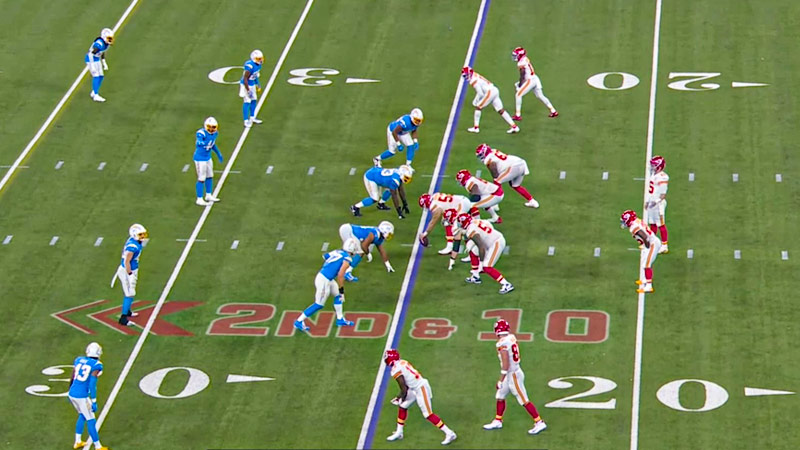
Yes, a chop block is illegal in football. In American football, and many other forms of football, the chop block is considered a dangerous and potentially injurious blocking technique.
As a result, governing bodies have established strict rules and regulations to make it illegal and penalize any team that attempts to use this technique during a game.
The rules regarding chop blocks may vary slightly depending on the level of play and the specific rules of a given football league.
Why is Chop Block Illegal in Football?
The chop block is illegal in football due to concerns about player safety. This blocking technique has the potential to cause serious injuries, particularly to a defender’s knees and lower body.
Here are the key reasons why the chop block is prohibited in football:
Injury Risk
The primary reason for banning the chop block is the substantial risk of injury it presents. Football is a physical sport, and injuries are a part of the game, but the chop block amplifies that risk significantly.
By intentionally targeting a defender’s legs or knees, the likelihood of severe injuries like torn ligaments, dislocated knees, or fractures is much higher.
The abrupt and unexpected nature of the chop block can make it challenging for a defender to protect themselves or brace for the impact, thus increasing the potential for injuries.
Long-Term Impact
Injuries resulting from chop blocks can have a profound and lasting impact on a player’s career and quality of life.
For some, these injuries can be career-ending. Recovery from such injuries often requires extensive rehabilitation and medical treatment, and players may never fully regain their previous level of performance.
The long-term consequences of such injuries highlight the importance of eliminating or strictly regulating the chop block.
Fair Play
Football, like all sports, places a strong emphasis on fair competition. The rules and regulations are designed to ensure that the outcome of a game is determined by the skill, strategy, and teamwork of the players, rather than by unfair or potentially dangerous tactics.
The chop block, which effectively neutralizes a defender through a high-low double-team block, can give an unfair advantage to the offensive team. This runs counter to the principles of fair play and sportsmanship that underpin the sport.
Emphasis on Player Safety
Over the years, football has evolved with a growing emphasis on player safety. The sport recognizes that it involves a level of risk due to its physical nature, but it has taken significant steps to minimize unnecessary risks.
Prohibiting the chop block is part of this broader commitment to player safety, as it eliminates a highly risky and dangerous maneuver from the game.
Rules and Regulations
Football organizations and governing bodies, such as the National Football League (NFL) and NCAA, have established strict rules to ensure the safety of all players on the field.
These rules explicitly prohibit dangerous techniques like the chop block and impose penalties on teams that use them.
The existence of these rules ensures a level playing field while safeguarding the welfare of the athletes.
Are Chop Blocks Legal in High School Football?
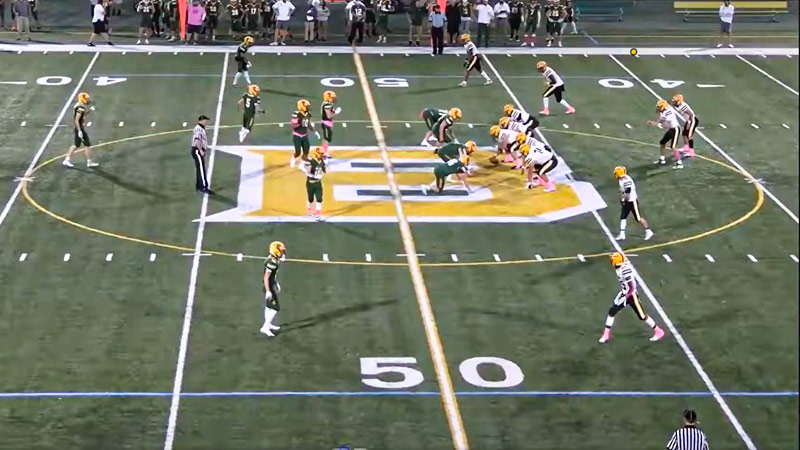
Chop blocks are illegal in high school football for many of the same reasons they are banned in college and professional football.
The rules and regulations governing high school football are often adapted from the rules established by national and international football organizations, with an emphasis on player safety and fair play.
Here are the specific reasons why chop blocks are illegal in high school football:
Player Safety
High school football players, like their college and professional counterparts, are susceptible to injuries.
Younger players may not have fully developed physically, which can make them more vulnerable to injury.
Banning chop blocks reduces the risk of severe injuries, such as knee or leg injuries, which can have a lasting impact on a player’s health and future athletic endeavors.
Consistency
High school football typically follows many of the same rules as higher levels of the sport. Consistency in rules helps young players learn the fundamentals of the game and prepares them for college or professional play.
By prohibiting chop blocks at this level, players develop proper blocking techniques that emphasize safety and fairness, which they can carry with them into higher levels of the sport.
Fair Competition
High school football aims to provide a level playing field where the outcome is determined by the skill, strategy, and teamwork of the players rather than by dangerous or unfair tactics.
Allowing chop blocks could create an imbalance in the game, as they provide a substantial advantage to the offensive team while placing the defensive players at risk. By prohibiting this technique, high school football ensures fair competition.
Learning Proper Techniques
High school football is an opportunity for young athletes to learn the fundamentals of the sport, including safe and legal blocking techniques.
By teaching players the importance of proper blocking methods and prohibiting the use of chop blocks, coaches and educators instill essential values of player safety and sportsmanship from an early age.
Adherence to National Federation of State High School Associations (NFHS) Rules
High school football typically follows the rules and guidelines set forth by organizations like the NFHS.
These governing bodies prioritize safety, and the NFHS rules reflect this commitment by prohibiting chop blocks and other potentially dangerous techniques.
Impact of Notable Chop Block Incidents in Football

Chop block incidents in football, especially those that lead to significant injuries or rule violations, can have various outcomes. These outcomes may include penalties, fines, suspensions, and even changes in the rules.
Here are some notable chop block incidents and their results:
Tom Brady’s Injury (2008)
In 2008, New England Patriots quarterback Tom Brady suffered a season-ending knee injury as a result of a low block by a Kansas City Chiefs player.
This incident emphasized the dangers of chop blocks, leading to increased scrutiny and stricter enforcement of related rules to protect quarterbacks.
NFL Rule Changes (2016)
In 2016, the NFL made changes to the rulebook regarding chop blocks, further restricting when and how this technique can be used.
The intent was to enhance player safety by clarifying the circumstances under which chop blocks are prohibited.
J.J. Watt’s Criticism (2017)
Houston Texans defensive end J.J. Watt criticized the NFL’s rules concerning chop blocks and their impact on defensive players.
He argued that the rules made it difficult for defenders to protect themselves and avoid injury when facing double-team blocks.
Richie Incognito Suspension (2017)
Richie Incognito, then a Buffalo Bills offensive lineman, was suspended for a game in 2017 for an illegal chop block.
This incident highlighted the consequences for players who use illegal blocking techniques, both in terms of on-field penalties and league-imposed suspensions.
Evolving Enforcement (Ongoing)
The NFL and other football leagues continue to evolve their rules and enforcement mechanisms to minimize the risk associated with chop blocks.
Strict penalties, education, and changes to the rulebook reflect ongoing efforts to prioritize player safety.
Player Advocacy for Safety (Ongoing)
Various players and advocacy groups have been vocal about the need to reduce the risk of chop block-related injuries.
Their efforts have contributed to ongoing conversations and rule adjustments aimed at safeguarding players.
How Do the Officials Call a Chop Block During a Game?
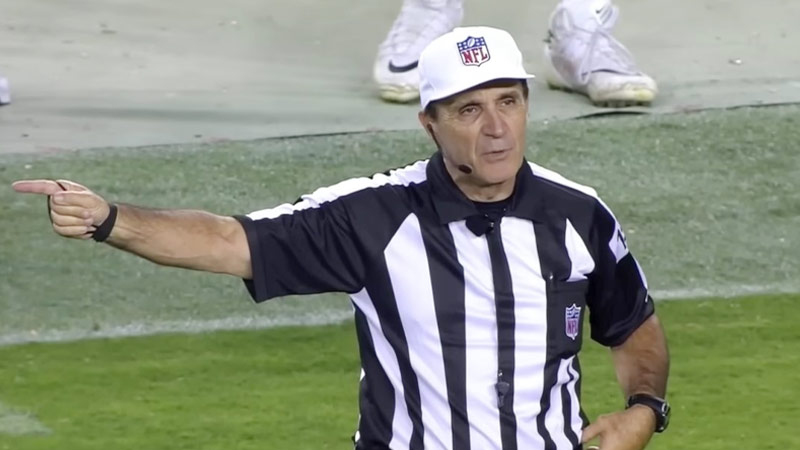
Football officials are responsible for identifying and calling a chop block during a game to enforce the rule and maintain player safety.
Here is how officials identify the chop block:
Observation
Football officials are trained to closely watch the actions of offensive and defensive players, especially in the trenches where blocking is intense.
They observe the interactions between players on the line of scrimmage and the engagement of offensive players with defenders.
Suspicious Block
To identify a chop block, officials first need to see a combination of actions involving two offensive players and one defensive player.
One offensive player will typically engage the defender high (above the waist), while another offensive player will simultaneously block the same defender low (at or below the waist).
Position on the Field
Officials will take into account the location on the field where the alleged chop block occurs. In the NFL and college football, chop blocks are typically not called on passing plays if they occur within the “tackle box” (the area between the two offensive tackles).
However, there are variations in the rules between different football leagues, so officials must be aware of the specific rules in their jurisdiction.
Timing
The timing of the high and low blocks is crucial. For a chop block to be called, both blocks must occur almost simultaneously.
If there is a significant delay between the high and low blocks, officials may not consider it a chop block.
Reaction from the Defender
The reaction of the defender who is the target of the chop block is also taken into consideration.
If the defender is knocked off balance, falls, or appears to be at risk of injury as a result of the high-low block combination, this raises the likelihood of a chop block penalty being called.
Signal and Penalty
When an official observes a potential chop block and believes it to be a violation of the rules, they will throw a penalty flag, stopping play.
The official may then make a specific signal, typically indicating a chop block by extending one arm horizontally at shoulder level and the other arm diagonally toward the legs to illustrate the high-low blocking combination.
Announcement
The official will announce the penalty to the players and the crowd, specifying the nature of the infraction (i.e., “chop block”) and the number of the player responsible for the illegal block.
Enforcement
The chop block penalty results in a loss of yardage for the offensive team. In the NFL and college football, it is typically a 15-yard penalty assessed from the line of scrimmage.
The defensive team is awarded the yardage and a first down if it results in a first down being achieved.
Chop Block Penalty: the Rules
The chop block penalty is a specific rule in football designed to protect player safety and maintain the integrity of the game.
This penalty prohibits a certain blocking technique that involves a combination of actions by two offensive players against one defensive player.
Understanding the rules surrounding the chop block is crucial for players, coaches, and officials.
Key rules and details regarding the chop block penalty include:
Illegal Blocking Technique
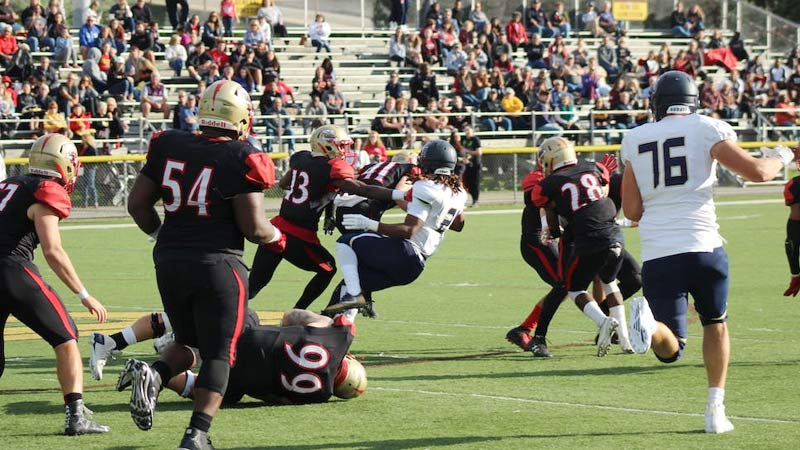
A chop block penalty occurs when one offensive player blocks a defender high (typically above the waist), while another offensive player simultaneously blocks the same defender low (at or below the waist).
This coordinated high-low block is considered illegal and dangerous because it can lead to severe injuries, particularly to the defender’s knees and lower legs.
Simultaneous Action
For a chop block to be called, the high and low blocks must happen almost simultaneously. If there is a noticeable delay between the two blocks, officials may not consider it a chop block.
The key factor is that two offensive players work in tandem to execute the high-low block.
“Tackle Box” Consideration
In both the NFL and college football, there are specific rules regarding the location on the field where a chop block can be called.
In many cases, chop blocks are not penalized on passing plays if they occur within the “tackle box,” which is the area between the two offensive tackles.
However, there may be variations in these rules depending on the specific league or level of play.
Player Position
The player responsible for the high block must typically be positioned in an upright stance, while the player delivering the low block is usually in a crouched or lower position. This combination of actions is what defines the chop block.
Penalty Enforcement
The penalty for a chop block varies depending on the level of play, but it generally results in a significant loss of yardage for the offensive team.
In the NFL and college football, a chop block typically results in a 15-yard penalty assessed from the line of scrimmage.
The defensive team is awarded the yardage, and if the penalty results in a first down being achieved, the offense retains possession.
Exceptions
Some situations permit the use of a chop block without incurring a penalty. These exceptions typically apply to passing plays, screenplays, or situations where a player is legally lined up at the line of scrimmage. Understanding these exceptions is essential for players and coaches.
Player Safety
The primary purpose of the chop block rule is to protect the safety of all players on the field. By penalizing this dangerous blocking technique, the rule aims to reduce the risk of severe injuries, particularly to the lower body of defenders.
How to Avoid Chop Block by Offensive Players
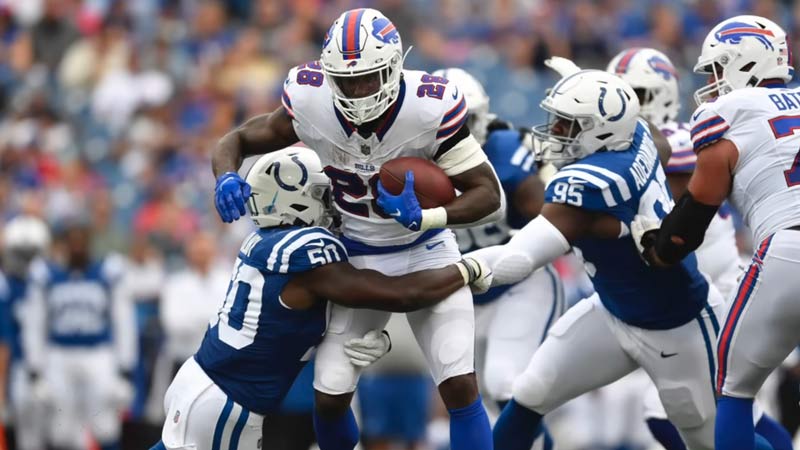
Avoiding a chop block by offensive players is essential for defensive players to protect themselves and maintain their safety on the field.
Here are some tips for defensive players on how to avoid chop blocks:
Maintain Awareness
Defensive players should constantly be aware of the actions of the offensive linemen. Watch how they move and interact during the play. Look for any signs that suggest a potential chop block, such as one offensive lineman dropping low while another maintains a higher block.
Maintain Proper Leverage
To avoid chop blocks, defensive players need to maintain proper leverage. This means keeping a low stance, bending their knees, and balancing their weight well.
By doing so, it becomes more challenging for offensive linemen to execute an effective chop block. Proper leverage also allows for better control of the engagement.
Use Your Hands
Defensive linemen can use their hands to engage and control offensive linemen. This allows for separation and prevents the offensive player from getting into a position to execute a chop block effectively. Effective hand usage is essential to keep the opponent at a safe distance.
Keep Your Feet Moving
Continuous foot movement is vital. It makes it harder for offensive linemen to establish a clear angle for a chop block. Defensive players should stay agile, remain on their toes, and be prepared to react swiftly to the movements of the offensive linemen.
Maintain Gap Control
Defensive players should focus on maintaining their assigned gap or area of responsibility. Staying disciplined in gap control reduces the chances of being caught in a situation where a chop block becomes necessary for the offensive player.
Be Cautious When Engaged
When engaged with an offensive lineman, defensive players should be cautious of their movements.
If an offensive lineman suddenly drops low while the defensive player is engaged high, they should be prepared to disengage quickly and avoid the chop block. Quick reactions are crucial.
Communicate with Your Teammates
Effective communication with fellow defensive players is key to avoiding chop blocks. Sharing observations about the offensive linemen’s actions and coordinating movements helps anticipate chop blocks and collectively protect the defensive line.
Recognize Formations and Plays
Studying the offensive formations and plays commonly used by the opposing team can help defensive players anticipate the offensive linemen’s blocking techniques. Recognizing these plays and formations can provide an advantage in avoiding chop blocks.
Practice with a Scout Team
To develop their skills in recognizing and avoiding chop blocks, defensive players can use a scout offense during practice. This allows them to simulate various blocking techniques, including chop blocks, under controlled conditions.
Stay Disciplined
Above all, maintaining discipline is essential. Defensive players should avoid making reckless moves or taking unnecessary risks that might put them in a vulnerable position for a chop block.
Prioritizing safety and adhering to sound defensive principles minimizes the risk of chop block attempts.
Types of Illegal Blocks in Football
There are several types of illegal blocks in football, each prohibited to ensure player safety and fair play. These blocks can result in penalties if committed during a game.
Here are some common types of illegal blocks in football:
Chop Block
As previously discussed, a chop block involves two offensive players blocking a single defender, with one player blocking high and the other player blocking low. This dangerous technique is illegal and can lead to severe knee and leg injuries.
Clipping
Clipping is when a player blocks an opponent from behind and below the waist. This type of block can be especially dangerous as it can cause defenders to be blindsided and sustain leg injuries.
Tripping
Tripping occurs when a player uses their leg or foot to trip an opponent. This is illegal because it poses a significant risk of injury, particularly to the tripped player, who may fall awkwardly.
Face Mask Penalty
Though not a block in the traditional sense, grabbing or twisting an opponent’s face mask is considered an illegal block. It can lead to serious neck and head injuries and is strictly prohibited.
Holding
While not a block, holding is a common illegal action in football. Offensive players are not allowed to hold onto an opponent’s jersey, pads, or body to impede their progress. Holding is a common penalty that can nullify a play.
Illegal Hands to the Face
Offensive and defensive players are prohibited from striking an opponent’s face mask or using their hands to push or punch an opponent’s head or neck area. This is illegal and can result in penalties.
Illegal Block in the Back
This penalty is called when a player blocks an opponent in the back, typically when the opponent is unaware and unable to defend against the block. It can lead to dangerous situations and is therefore illegal.
Illegal Cut Block
Similar to a chop block, an illegal cut block involves a player diving at an opponent’s legs in a way that is considered unsafe or illegal. Cut blocks are sometimes allowed in specific situations, but illegal ones are penalized.
Blindside Block
A blindside block occurs when a player blocks an opponent who does not see the block coming. These are usually called as penalties to protect players from unexpected and potentially harmful hits.
Crackback Block
A crackback block occurs when an offensive player moves to block an opponent from the side or back, often after they’ve just moved away from the line of scrimmage. This type of block can be dangerous and is illegal.
FAQS
Why is the chop block considered a risky strategy in football?
The chop block is risky because it can result in serious injuries, especially to a defender’s knees and legs.
The technique’s high-low combination poses a significant threat to player safety.
Are there any situations where chop blocks are legal in football?
In some cases, such as within the tackle box (the area between the offensive tackles) and under specific conditions, chop blocks might be considered legal.
However, these conditions are strict and vary depending on the level of play.
How do officials determine if a chop block is illegal during a game?
Officials watch for the timing and position of the offensive players involved in the block. If the low block occurs while the defender is already engaged high by another player, it’s generally considered illegal.
What are the typical penalties for committing a chop block in football?
Penalties for an illegal chop block often result in a 15-yard loss of yardage for the offending team. In some cases, if the block is particularly egregious or dangerous, it can lead to player ejections.
Do all levels of football have the same rules regarding chop blocks?
While the basic concept of the chop block is consistent across levels of play, specific rules and enforcement may vary between high school, college, and professional football.
Wrap Up
In the realm of American football, the “chop block” serves as a stark reminder of the delicate balance between strategy and player safety. It’s a technique that, while once accepted, has faced increased scrutiny due to its potential for catastrophic injuries.
Football’s stringent regulations on the chop block are a testament to the sport’s evolving commitment to safeguarding its athletes.
Through rule changes, increased awareness, and penalties, football seeks to ensure fair competition without compromising player well-being.
The narrative of the chop block in football is one of adaptation, emphasizing that success in the game can and should coexist with the safety and welfare of those who take the field.

